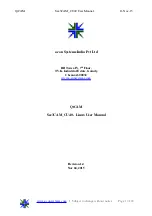
V1.02
Thom Hogan’s Complete Guide to the Nikon D300
Page 55
range (i.e. green). Likewise, green light waves are in between
the red and blue positions in the spectrum, and are found to
some degree in most visible colors. Duplicating the green
value gives the camera a better chance at discriminating
between small differences in color and the amount of light
(luminance) in a scene. (Photosites are least responsive to
blue wavelengths [~400-500 nm], which produce other
problems we’ll discuss later.)
If you’re saving images in NEF format (see “NEF format” on
page <150>), the camera simply saves the values it recorded
at each photosite into a file (along with some additional
camera data). Note that this is
not
color data, but simply a
count of the photons converted to electrons collected at each
photosite during the exposure. (Remember, there’s a color
filter above each photosite that only allows a limited set of
wavelengths—colors of light—to pass through.) Software on
your computer (Nikon Capture NX or one of the many third-
party RAW file converters that are available) is then used to
interpret the photosite information to produce the actual RGB
values of your visible image.
If you’re saving images in JPEG format (see “JPEG” on page
<131>), the camera must first process the photosite data into
image data. It does this by a process called
interpolation
18
.
Interpolation looks at a block of photosite data and “guesses”
the actual RGB values for any given photosite location
(remember, at any given photosite, the camera only sees Red,
Green, or Blue data, not all three; interpolation produces the
missing two data elements).
Most interpolation routines examine a 5x5 or larger block of
adjacent data to determine the actual RGB pixel value for any
given location. This is one reason for the difference in number
18
Technically, the actual name given to routines that convert Bayer pattern data into
RGB pixel data is
demosaicing
. (The data is a
mosaic
of color information, and that
mosaic must be reinterpreted into image data, thus the routine is called de-mosaic-
ing.)
Interpolation
is a more general name given to any conversion that involves
creating new data from partial or smaller datasets.
















































